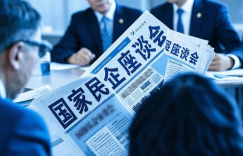
Today we are going to talk about the exchange rate. I know that many people don’t care about the exchange rate, thinking that they don’t go abroad or do foreign trade, so the exchange rate has nothing to do with it. This is exactly what I want to remind you, because the exchange rate, which seems far away, is actually very relevant to us.
China is now entering a new round of “exchange rate defense war”. Why must the exchange rate be protected? What huge impact does this have on our personal assets? Let’s answer these questions today.
Okay, let’s get to the point.
From the end of last year to January this year, the exchange rate of the RMB against the US dollar depreciated from 7.25 to a minimum of around 7.37. This almost set a record for the lowest value in 11 years, and it was also the deepest depreciation of the RMB since the “812 Exchange Rate Reform” in 2014, and the stock market has also seen a wave of declines since the beginning of this year. Pay attention to my statement, the RMB depreciated and the stock market also plummeted. I think this actually represents capital selling Chinese assets and withdrawing from China.
The central bank’s exchange rate protection measures: the game behind the stable exchange rate
Faced with this situation, the country has also decisively taken a series of “exchange rate protection” actions. Simply put, it is to reduce the “commodity” of RMB in the market and increase the “commodity” of US dollars, so that the exchange price of RMB against US dollars will naturally stabilize.
For example, the central bank uses buy-back to replace the medium-term lending facility (MLF), and has net withdrawn more than 200 billion yuan of funds after the beginning of the year. It is to replace long-term funds with short-term funds. Simply put, the money issued by the central bank was originally to be recovered after one year, but now it has to be recovered after one month, so the funds in the market will be tighter, so the circulation of RMB in the short term will be reduced.
For example, the central bank issued 60 billion offshore central bank bills in Hong Kong, which is the largest issuance in history, to absorb excess RMB in the overseas market. Simply put, the People’s Bank of China issued a large number of bonds, and everyone wanted to buy bonds, so they gave the RMB in their hands to the central bank, so there was less RMB in the overseas market.
For another example, the central bank publicly announced the suspension of the purchase of government bonds. Simply put, it means that the RMB will no longer be released into the market by buying government bonds, so the RMB will also be reduced.
For example, the central bank raised the macro-prudential adjustment parameters for cross-border financing of enterprises and financial institutions from 1.5 to 1.75. Simply put, it means that enterprises and banks are allowed to borrow more US dollars from outside, and then put the borrowed US dollars into the market. When there are more US dollars, the RMB will rise against the US dollar.
After I said this, you can feel that the core idea of the central bank is to reduce the circulation of RMB in the market and increase the supply of US dollars. After the above four measures, the RMB exchange rate has generally stabilized and rebounded to around 7.3, and then the stock market has also rebounded. In three trading days, the Shanghai Composite Index rose by more than 5%, and the ChiNext rose by 11%.
Have you noticed this strong relationship? I think that Chinese assets have increasingly shown a new feature of “stock and exchange in the same direction”. That is, the RMB exchange rate rises, the stock market rises, and vice versa.
Okay, let me continue. Now that Trump has come to power, the outside world generally believed that China would devalue the RMB to hedge the losses from the decline in foreign trade. But I think that the recent series of actions of the central bank have made it very clear that the exchange rate is the top priority at this stage, and the priority of foreign trade is declining. Pay attention to my judgment, it is very important.
We can also find this out from a series of recent statements:
On December 27, 2024, the central bank’s fourth quarter regular meeting re-wrote the “three resolutes” into the announcement, that is, resolutely deal with behaviors that disrupt market order, resolutely prevent the formation of unilateral consistent expectations and self-realization, and resolutely guard against the risk of overshooting of the exchange rate. This has already emphasized the protection of the exchange rate. The tone of the economy is “generally stable”. I think the meaning behind it is that everyone should not be in a hurry, and keep the exchange rate first and wait and see.
On December 31, at the Central New Year Tea Party, the top leaders reiterated the term “strategic determination”. This term has a special meaning in political economy, which means to be patient in the face of pressure, and still means not to be in a hurry.
On January 8, at the press conference of the State Council Information Office of the National Development and Reform Commission, the head of the National Development and Reform Commission mentioned “solidifying the foundation and nourishing the essence” again after half a year. This term has a distinct “Chinese medicine-style” chronic and stable meaning, which also means not to rush.
So at present, in terms of monetary policy, maintaining the exchange rate is the priority, while foreign trade exports and maintaining asset prices, especially maintaining housing prices, should be temporarily put on the back burner.
The dilemma of “maintaining the exchange rate” and “protecting assets”
Speaking of this, some people may ask why “maintaining the exchange rate” and “protecting assets” cannot be achieved at the same time? I will briefly explain here that when the economy is on the rise, there is actually no such problem of who to protect and who not to protect. For example, the exchange rate and housing prices rose together before; but when the economy is under pressure, due to various factors, such as geopolitical risks, trade risks, asset yields, etc., foreign capital wants to withdraw, they will sell their assets here, such as real estate, stocks, and bonds, and exchange them for RMB, and then convert RMB into US dollars and remit them abroad. At this time, the question of “maintaining the exchange rate” or “protecting assets” will arise. At this time, if you want to keep the exchange rate strong, then you have to let foreign capital leave smoothly, and their actions of selling assets to realize profits will cause domestic asset prices to fall. If you don’t want domestic assets to fall, then the country can choose to devalue the exchange rate. Foreign capital feels that it is not cost-effective to exchange RMB for US dollars, so they grit their teeth and stay in the country.
For example, China encountered this problem two years ago. Foreign capital withdrew in large quantities. China faced the problem of whether to maintain the exchange rate or the housing price. China chose to maintain the exchange rate, which was one of the reasons why housing prices began to fall at that time.
As for why it is mainly the housing price that fell? It is because wealth has different main forms in different countries. For example, China’s largest wealth is the real estate market, the United States is the stock market, and Japan is the bond market. Therefore, Japan faces the problem of “maintaining the exchange rate” or “maintaining the national debt”, while China faces the problem of “maintaining the exchange rate” or “maintaining the housing price”. The United States does not have this problem because its native currency is the US dollar.
Behind this problem, in fact, is what is called the impossible triangle in economics: capital flow, exchange rate stability, and monetary independence, all three cannot be achieved at the same time.
Some people may continue to ask, why do we still need to stabilize the exchange rate when internal asset prices are under pressure?
The reasons are quite complicated. I will mainly talk about four of them here:
First, the exchange rate is the market that is most likely to form a vicious depreciation cycle, and it will be self-reinforcing. Once it falls into a depreciation cycle, it is difficult to stop it. For example, the Argentine peso, the Turkish lira, the Egyptian pound, etc., once they start to depreciate sharply, it is difficult to curb them, and they also bring about hyperinflation.
Second, China’s exchange rate system is a kind of anchoring system similar to the linked exchange rate system. Although it will also float freely, it is still anchored to the US dollar to a large extent. Next, let’s make a deduction of an extreme case. Note that this is only a theoretical extreme deduction. Once the RMB depreciates viciously, both foreign and domestic capital may fall into panic selling and want to exchange for US dollars as soon as possible to leave China. At this time, the real estate market, stock market and various Chinese assets are not a problem of falling, but they are easy to collapse. If the exchange rate deteriorates further, these funds cannot leave the country because they are controlled or feel that the loss of converting to US dollars is too great. In order to preserve the value of funds, they will convert all the money into materials on a large scale, which will trigger hyperinflation. So you see, although the first result of protecting the exchange rate will cause domestic assets to fall, the second result is to prevent the collapse of domestic assets, and the third is to prevent hyperinflation. Now you can easily understand why protecting the exchange rate is important.
Third, the instability of the RMB exchange rate will give international speculative hot money an opportunity to take advantage of the situation. The examples of Hong Kong, Thailand, Malaysia and other countries and regions being looted by international capital in 1997 are still vivid. It is still the logic of protecting the exchange rate and protecting wealth. We must prevent a country’s wealth from being looted.
Fourth, and more fundamentally, the domestic real estate market and stock market are all denominated in RMB. In any case, they are all internal contradictions. In any case, China is still capable of solving and covering the bottom of RMB assets. But the exchange rate is denominated in US dollars, which is an external contradiction, and China’s control ability will be weaker.
So after understanding these, you will understand why the country cares so much about the stability of the RMB exchange rate.
Impact of individual decision-making
So what impact will this have on our current decision-making?
First, the current policy faces the trade-off between maintaining the exchange rate and maintaining assets. Since the exchange rate has been clearly chosen in the short term at this stage, you should have a rough judgment on asset prices, including the real estate market, and investments should be directed towards assets with high value preservation. For example, houses in the core areas of large cities are obviously better than those in third- and fourth-tier cities.
Secondly, maintaining the exchange rate at this stage means that the timing of monetary policy easing may be pushed back, waiting for the exchange rate to stabilize and for the Federal Reserve to confirm that it will not turn back. You should be aware of this window, guard the nodes well, and avoid stepping on empty. Specifically, just keep an eye on the US dollar interest rate. When the US dollar interest rate steadily declines and this downward trend can be stabilized in an predictable manner, it may be a signal that China will further increase monetary easing.
Furthermore, the Hong Kong market may become a “flood discharge outlet” for policies. Simply put, it is better to guide capital to Hong Kong than to directly settle foreign exchange in the mainland to go abroad. I think that the central government wants to “discharge the flood” and will expand the channels for mainland funds to go to Hong Kong. Therefore, in the future, cross-border wealth management, mutual recognition funds, and Hong Kong RMB deposit products may be further expanded to the mainland to guide money to Hong Kong. This is also a way to preserve and increase value for mainland investors. For example, the domestic deposit interest rate may be only 1.5%, but Hong Kong can follow the US dollar and the interest rate can reach 5%.
The last one is especially for professional foreign trade business practitioners. If you have relevant people around you, you are welcome to share this article with them. Trump may push up US inflation expectations after taking office, and the expectation of RMB depreciation still exists, but the central bank will take action at any time to suppress shorts, that is, to suppress investors who short the RMB. Therefore, for foreign trade companies, hedging strategies of long or short RMB are not suitable, because simply betting on the unilateral trend of the RMB exchange rate is very dangerous.



